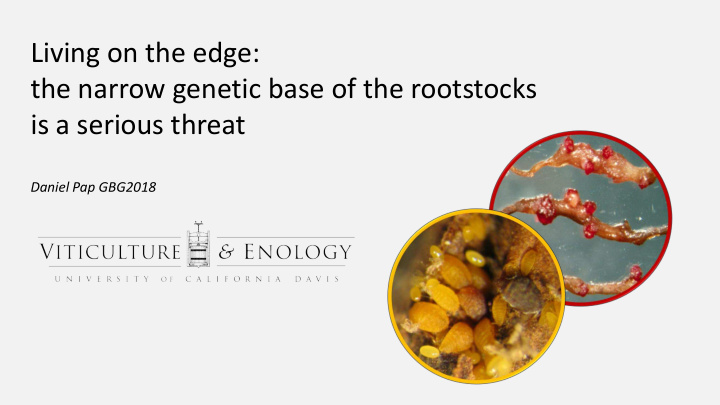



Living on the edge: the narrow genetic base of the rootstocks is a serious threat Daniel Pap GBG2018
VIT ITIS IS ROOTSTOCK - Narrow genetic base? Gloire de M., Rességier 2, du Lot contribution to the total genetic background is 40% Chloroplast haplotype diversity limited – few mother lines In California: minimal requirements are: Root-knot nematode resistance, Phylloxera resistance Principal Coordinate Analysis of Rootstocks and Reference Species
Root-Knot Nematode Resistance and Pathotypes Teleki 5 C SO4 Pathotype ID Species Kober 5 BB Glorie de Mpt. Race3 M. incognita Schwarzmann Harmony-C M. incognita 99R 1103P Harmony-A M. arenaria St. George 110R 140Ru Börner Dog Ridge Ramsey Freedom 1613C Harmony 101-14 3309C 44-53 420A 1616C 0 0.1 R to Race3 R to both Race3/Harm Susceptible (some level ) Based on Ferris et al 2012
Nematode mapping efforts (o (on going) • Resistance on Chr 18 (GRN2 / GRN4 / GRN5) (based on Bulk Segregate Analysis) • MJR1 – Chr18 - M. javanica (Smith et al. 2018) V. cinerea accession • Expanded mapping populations: GRN2/GRN4/GRN5 • New mapping populations V. cinerea / V. arizonica : b41-23, b45-26 RKN screen in the greenhouse
Phylloxera Biotypes – and Resistances? Astrid Forneck et al 2016 AJEV Biotype differentiation according to host performance V. vinifera Hybrids American Sp. Biotype TUB. NOD. LEAF TUB. NOD. LEAF TUB. NOD. LEAF A 5 5 0 2 2 5 0 2 5 Granett et al. 1985, King and Rilling 1985 B 2 2 0 5 5 0 0 2 5 Granett et al. 1985 C 0 2 0 5 5 5 0 5 5 King and Rilling 1985, Forneck et al 2001, Kocsis et al 2002 D 2 2 0 0 5 ? 0 5 5 Kellow et al 2002, Corrie and Hoffmann 2004 E 5 5 0 5 5 ? 5 5 0 Resistant Powel and Kristic 2015 • AXR#1 break down in California (B biotype) F 5 5 5 ? ? ? ? 2 5 AAX MA Walker • Teleki 5C virulent phylloxera in EU Susceeptible G ? ? 5 ? 5 5 ? 2 5 Forneck et al 2016 • Quick spread of New – leaf feeding from in CA
Resistance to B biotype Map generated for V. vinifera F2-35 × V. arizonica-girdiana b42-26 Pierce’s Disease R mapping RDV2 identified on Chr18 Greenhouse evaluation in perlite filled bins Excercised roots in Petri dishes
Californian Foliar Phylloxera • This biotype feeds on roots (for e.g. 1103P roots) • V. vinifera F2-35 × V. berlandieri 9031 • Segregates 1:1 for (pseudo)Tuberosity in excised root assays Trait: not feeding through the cortex of the root, but allows feeding on root tips, callus tissue (Nodosity)
Summary ry • Narrow genetic base of the existing rootstock is a threat • Need for new resistance sources • Need for understanding genetics of resistances • Establish marker assisted selection • Need to keep up with the everchanging pest • We should not forget to look below ground
Acknowledgement Summaira Riaz Nina Romero Funding Sources Rebecca Wheeler-Dykes M. Andrew Walker California Grape Rootstock Improvement Commission Karl Lund California Grapevine Rootstock Research Foundation Astrid Forneck CDFA Improvement Advisory Board California Table Grape Commission Louis P. Martini Endowed Chair funds
Recommend
More recommend